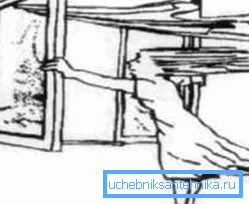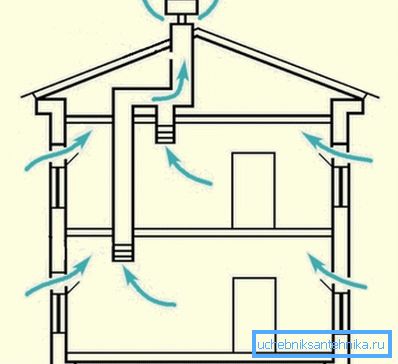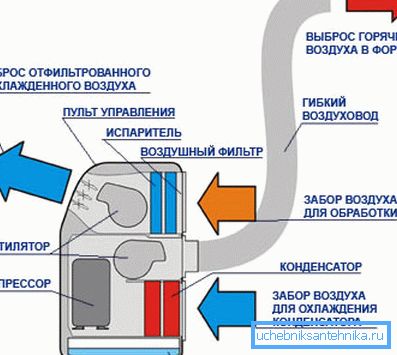Air ventilation systems - security of our house
A healthy microclimate in a single room or building as a whole is vigilantly guarded and maintained by ventilation systems. They provide a balanced composition of air, humidity and temperature.
It is air ducts that provide rapid removal of harmful fumes and simply polluted air from the premises. Therefore, normally working ventilation is a guarantee of human health.

Breath on modern technology
The rhythm of today's life requires the automation of many processes, for the uninterrupted provision of air exchange in the room. Modern ventilation and air conditioning systems are a separate production, which certainly supplies oxygen.
Airing with the help of open windows is suitable for a leisurely life outside the metropolis. It is desirable only that there was no strong wind, cold and rain. In any case, the penetration of dust and the formation of drafts - an integral part of primitive ventilation.

Variants of ventilation
The ventilation and air conditioning system is used to constantly change the "exhaust" air to fresh, enriched with oxygen.
This happens in several ways:
- natural;
- artificial or mechanical;
- air conditioning.
Low cost ventilation
Natural exhaust ventilation is based on the difference between internal and external temperature. In accordance with SNiP 41-01-2003, air is taken in through the air vents of the living rooms and removed through the exhaust grilles of bathrooms, toilets and kitchens. The air exchange rate is set depending on the size of the room.

At the beginning of the era of mass construction, multi-storey buildings were equipped with ventilation with individual exhaust ducts. They were connected to a common exhaust mine or a collective canal in the attic. Such a scheme still exists in 5 floors.

In the skyscrapers, horizontal shafts approached a common vertical channel. Air flowed in them from vertical channels of every 4–5 floors. Otherwise, modern ventilation systems - air ducts, forming a kind of blocks.
Through the exhaust grilles from each apartment on the site air enters the side branches. From the level of interfloor overlap, located a higher level, the air flow from the "appendages" enters the central highway.

This engineering solution is smaller and safer than individual channel schemes. It has the best aerodynamic and fire characteristics.
In order to avoid heat losses, corresponding attics in height up to 1.9 m are equipped. A stream from common vertical channels moves here. Outward it is displayed through several (depending on the number of entrances) exhaust shafts.

Note! Ventilation equipment should be perpendicular to the longitudinal walls. This is achieved by the free movement of air flow.
The advantages of natural ventilation include:
- simplicity of the device;
- low cost;
- the ability to ventilate large areas with large heat dissipation.
The disadvantages of such infiltration are:
- in the absence of moisture;
- heat loss;
- the occurrence of drafts;
- inconsistency of the process;
- the absence of devices for dusting.
To cope with the imperfections of natural ventilation will help inlet devices that are easy to install with your own hands. They are located in the windows and bearing walls and allow you to adjust the volume, strength and direction of the air flow. The design of such devices minimizes noise penetrating from the street.

The external grille prevents debris from entering the duct, where the air flow “slows down” and normalizes the temperature. The valve, located on the inner surface of the wall / window, is equipped with a damper that regulates the flow of air. The location of the device in the immediate vicinity of the radiator, allows you to get already warmed air.
When artificial is better
An alternative to natural is mechanical - intake, exhaust or mixed-type ventilation. If the movement of air in natural ventilation systems occurs due to the difference in temperature and pressure, then artificial does not depend on these factors.

It is carried out with the use of various devices, which, in principle, are absent in the system of natural ventilation:
- Motorized Air Valve.
- Air heater used during the cold season. For small rooms, it is advisable to use an electric heater, but for heating an area of more than 100m2 water will be more profitable. Significant savings brings installation of ventilation and air conditioning systems using heat exchangers. In this device, the cold outside is heated by heat exchange with heated exhaust air, without mixing.
- Fan - gives fresh air and creates the necessary pressure in the system.

- Muffler. It suppresses additional noises in the air ducts made by the fan.
- Air ducts through which air is supplied to the rooms. The pipes form a network, for the installation of which tees, turns and adapters are used. When selecting a cross section, the rate of air exchange and the speed of the air flow are taken into account.
Note! Flexible air ducts for ventilation systems are composed by an accordion, which facilitates their transportation and installation. But the corrugated surface is a source of high aerodynamic pressure. Because of this, they are used only in areas of small length.
- Air distributors that distribute and disperse airflow in different rooms. The device can be made in the form of ceiling diffusers or round / rectangular gratings on the wall or ceiling.

- Electrical shield - a kind of remote control system. The elementary option is a switch with an indicator to turn on / off the fan. A more complex design involves automation elements using hygrostats, thermostats, pressure sensors, etc. This allows you to adjust the operation of the entire duct system and the non-stop ventilation system, for example, to automatically turn on the heater when cold air flows, to monitor the condition of filters , regulate the operation of valves.

Legacy of Willis Carrier
At the beginning of the twentieth century, American engineer Kerrier realized the idea of cooling a room. Modern units additionally clean (90%), warm, moisturize, disinfect the air.
In the conditions of a single apartment, cottage and premises up to 100 m2 use household condensing units with a capacity of 2-7 kW.
Their "stuffing" includes mechanisms:
- ventilation;
- coarse and fine cleaning, trapping up to 90% of dust;
- moisturizing;
- heating from central or autonomous heating;
- noise reduction;
- recovery (optional).
Air conditioners are divided into 2 types:
- Water cooled. They are powerful, their blocks can be at any distance from each other, cooled by running water. Inconvenient is the high price of the unit, complex calculation and installation.
- KKB with air cooling. They applied the principle of a split system. The advantages include simple installation and low cost, the disadvantages are low power.
Using a split or multisplit system brings certain benefits - quiet operation, remote control. Disadvantages should be found in the difficulties of installation or the problem of placement of the compressor unit. The split system unit does not supply fresh air into the room. The multi option, having an interconnected system of several blocks, can fail if only one of them breaks down.

To avoid the drawbacks inherent in both options, it is proposed to operate ventilation and air conditioning systems on the basis of the channel KKB. In this case, the air duct is connected to the indoor unit of the air conditioner. The design will hide the false ceiling.
Such a symbiosis will allow the addition of oxygen, simultaneously cooling / heating, cleaning, disinfecting and moistening it. As a result, one KKB will successfully serve several rooms. The only and doubtful drawback is the need for installation before interior decoration.

Air humidification
The humidification function in air conditioners is provided initially, and the moisture is taken from the atmosphere. When operating ventilation pipes, this problem requires an original solution - keeping moisture in the central duct.
Channel air humidifiers for the ventilation system saturate the incoming air jet with water aerosol, which subsequently evaporates. Devices that turn water into mist — spray plumes are installed in a parallel main duct. Here is the drip trap.

In other words, part of the incoming air from the main ventilation pipe enters a parallel section. From there it is already moistened, merges with the main stream. The diameter of the mist drops is negligible - 1–5 microns, which contributes to their complete evaporation, without forming a tropical effect.
Control of ventilation and air conditioning
Instructions for maintenance of air ducts and air conditioning systems in accordance with GOST 12.4.021-75 include:
- Seasonal preparatory work for the launch system.
- Preparation for work in a certain mode.
- Start and stop the system.
- Control of the ventilation process.
- Repair current and planned.
Work in the winter period is characterized by work on the insulation of the room, changing the oil to low temperature, the integrity of the system and heaters. Special attention is paid to possible emergencies related to the cessation of heat supply.

In the warm season, special attention is paid to the cold supply of air ducts - the construction of awnings, whitewashing of heated surfaces. Check the neutral position of all control levers, cleanliness inside the air ducts, airtight closing of the hatches.
Maintenance of ventilation and air conditioning systems also includes maintenance and overhaul. Routine repairs are aimed at eliminating minor damage and replacing parts.
Breakage of large components and assemblies require capital intervention. In this case, partial disassembly is performed with the elimination of the breakage on the spot or shipment to the factory.
Summarizing
Modern ventilation and air conditioning of the home is a unique opportunity to provide yourself with oxygen. Everyone can choose the optimal solution to the question of a comfortable stay at home. A competent installation and control of the air duct system allows you to make this process continuous.
If you opted for the air conditioner, the video in this article will tell you about the points that every buyer needs to know.